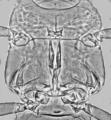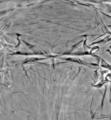Asprothrips seminigricornis
Recognition data
Distinguishing features
Female fully winged. Body, legs and wings almost white, antennal segments V–VIII dark brown. Antennae 8-segmented, III–IV each with forked sensorium, VI with long simple sensorium. Head with minute pair of setae between hind ocelli. Pronotum without long setae. Metanotum reticulate, median setae far behind anterior margin. Metathoracic endofurca elongate and lyre-shaped. Tarsi all 2-segmented. Fore wing slender, veinal setae minute, about 4 on both veins; posteromarginal cilia wavy. Abdominal tergites with median pair of setae small; tergite VIII with posteromarginal comb of short microtrichia medially.
Related and similar species
Only two other species are known in the genus Asprothrips, one from India and one from Japan, and in both of these the body is brown. The genus is considered to be a member of the Dendrothripinae, because of the elongate "lyre-shaped" metathoracic furca, but differs from species of Dendrothrips in having very short setae medially on the tergites (Mound, 1999).
Taxonomic data
Current valid name
Asprothrips seminigricornis (Girault)
Original name and synonyms
- Euthrips seminigricornis Girault, 1926: 2
- Scirtothrips antennatus Moulton, 1937: 409
- Asprothrips raui Crawford JC, 1938: 110
Family placement
Thripidae, Dendrothripinae
Biological data
Life history
Larvae and adults feed on leaves.
Host plants
Collected from a range of different plant species, with no evidence of any particular relationship.
Tospoviruses vectored
None
Crop damage
This species was noted to be damaging the leaves of Gardenia augusta in a greenhouse at Brisbane, in Queensland, Australia, and considerable numbers were collected from the leaves of Ricinus in northern New South Wales.
Distribution data
Area of origin
Possibly Australia
Distribution
USA (California; New York), Bermuda, Hawaii, Australia.






